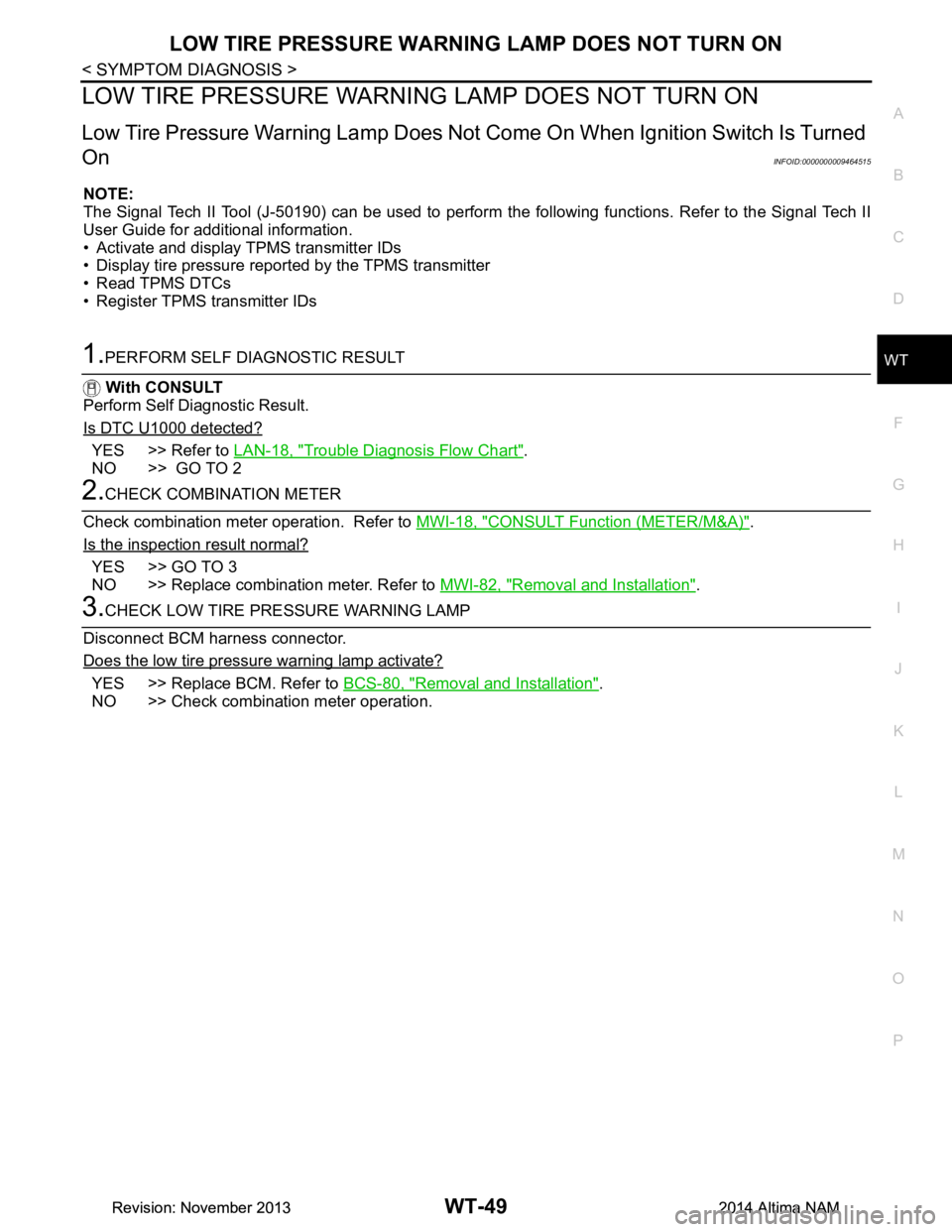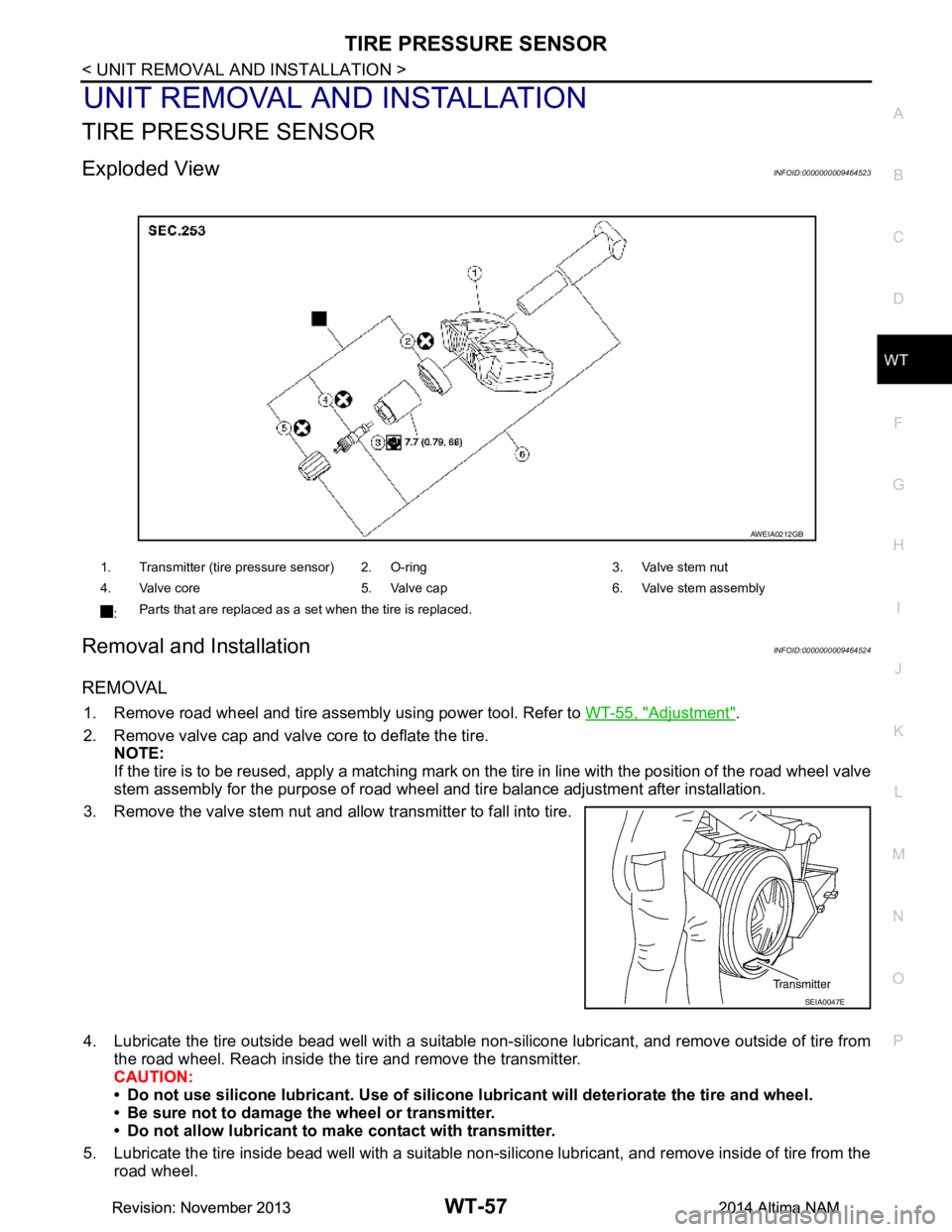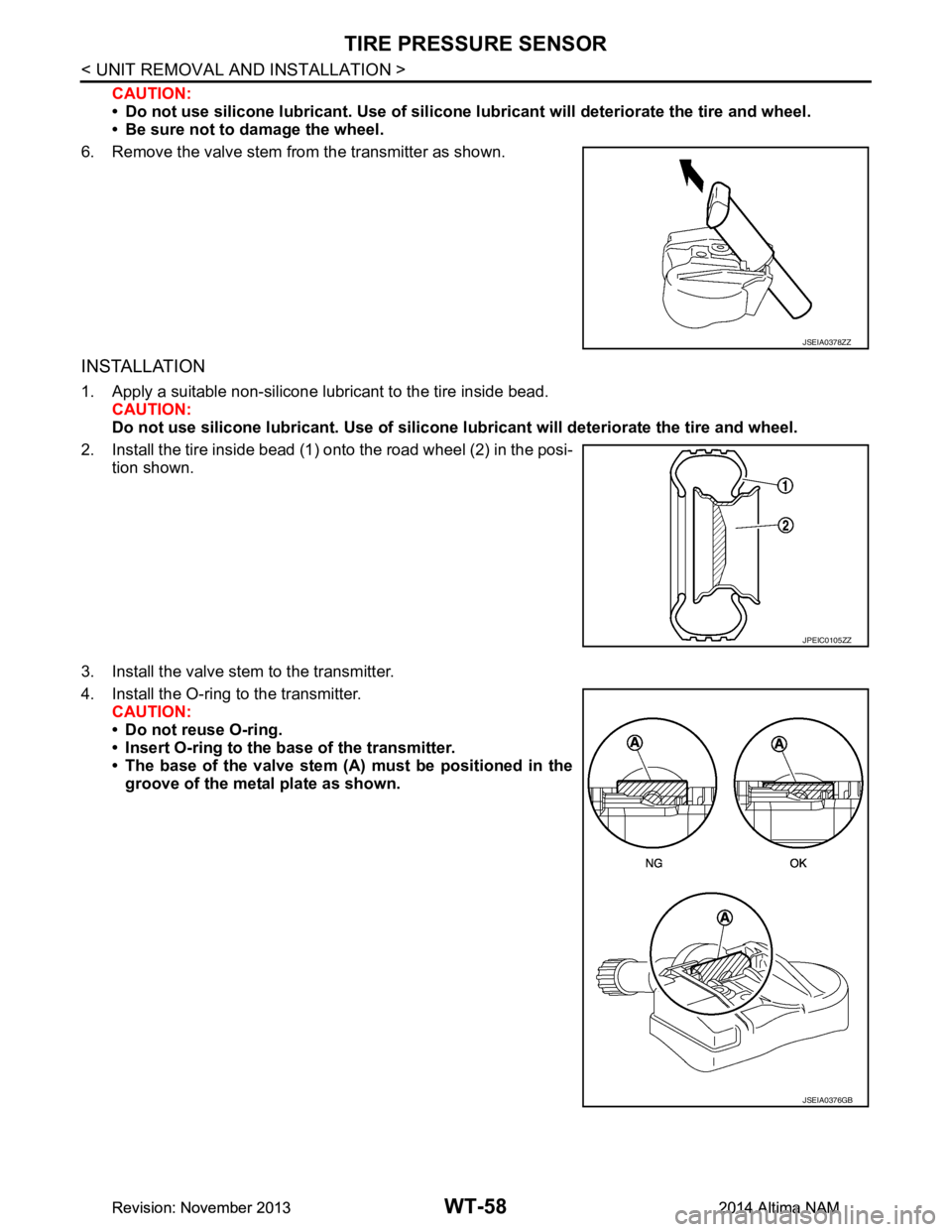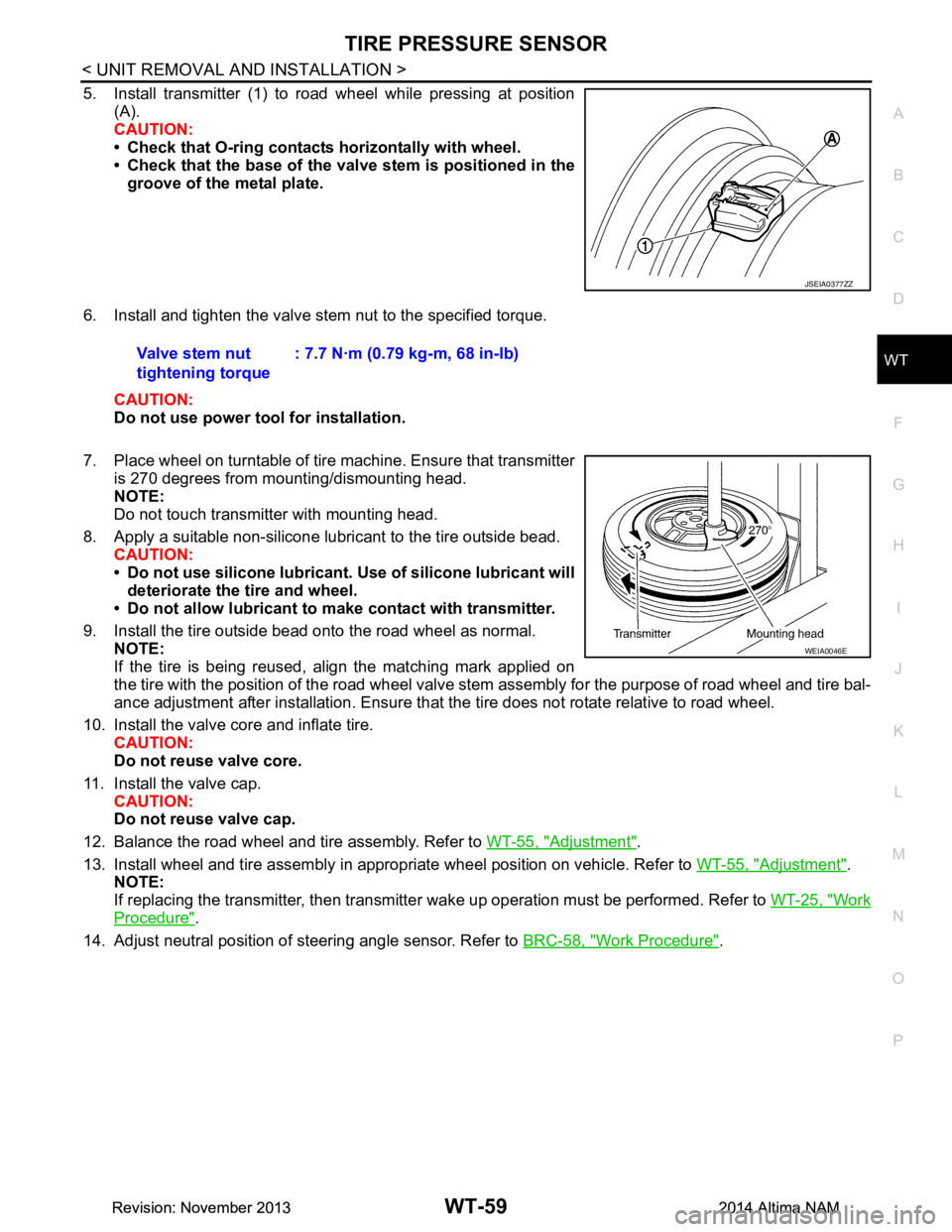tire pressure NISSAN TEANA 2014 Service Manual
[x] Cancel search | Manufacturer: NISSAN, Model Year: 2014, Model line: TEANA, Model: NISSAN TEANA 2014Pages: 4801, PDF Size: 51.2 MB
Page 4721 of 4801

WT-46
< DTC/CIRCUIT DIAGNOSIS >
C1735 IGNITION SIGNAL
C1735 IGNITION SIGNAL
DTC LogicINFOID:0000000009464512
NOTE:
The Signal Tech II Tool (J-50190) can be used to perform the following functions. Refer to the Signal Tech II
User Guide for additional information.
• Activate and display TPMS transmitter IDs
• Display tire pressure reported by the TPMS transmitter
• Read TPMS DTCs
• Register TPMS transmitter IDs
DTC DETECTION LOGIC
DTC CONFIRMATION PROCEDURE
1.PERFORM SELF DIAGNOSTIC RESULT
With CONSULT
Perform Self Diagnostic Result.
Is DTC C1735 detected?
YES >> Proceed to WT-46, "Diagnosis Procedure".
NO >> Inspection End.
Diagnosis ProcedureINFOID:0000000009464513
NOTE:
The Signal Tech II Tool (J-50190) can be used to perform the following functions. Refer to the Signal Tech II
User Guide for additional information.
• Activate and display TPMS transmitter IDs
• Display tire pressure reported by the TPMS transmitter
• Read TPMS DTCs
• Register TPMS transmitter IDs
1.CHECK CAN IGNITION SIGNAL
With CONSULT
1. Select Data Monitor from INTELLIGENT KEY of BCM.
2. Check IGN RLY1-F/B value.
Is the inspection result normal?
YES >> GO TO 2.
NO >> Check CAN system. Refer to LAN-18, "Trouble Diagnosis Flow Chart"
.
2.CHECK BCM POWER SUPPLY AND GROUND
Check BCM power supply and ground. Refer to BCS-74, "Diagnosis Procedure"
.
Is the inspection result normal?
YES >> GO TO 3.
NO >> Repair or replace harness or connectors.
3.DRIVE VEHICLE
Clear DTC and test drive vehicle to check for low tire pressure warning lamp.
Does the vehicle operate without any low tire pressure warning lamp?
CONSULT Display DTC Detectio n Condition Possible Cause
IGNITION SIGNAL LINE - BCM/TPMS
[C1735] BCM has detected a mismatch between IGN
ON signals. BCM
Monitor item Displayed value
IGN RLY1 F/B On with ignition in ON position
Revision: November 20132014 Altima NAMRevision: November 20132014 Altima NAM
Page 4723 of 4801

WT-48
< SYMPTOM DIAGNOSIS >
TPMS
SYMPTOM DIAGNOSIS
TPMS
Symptom TableINFOID:0000000009464514
Symptom Reference
Low tire pressure warning lamp does not come on when ignition switch is turned ON. WT-49
Low tire pressure warning lamp stays on when ignition switch is turned ON.WT-50
Easy fill tire alert does not activate.WT-51
Revision: November 20132014 Altima NAMRevision: November 20132014 Altima NAM
Page 4724 of 4801

LOW TIRE PRESSURE WARNING LAMP DOES NOT TURN ON
WT-49
< SYMPTOM DIAGNOSIS >
C
D
F
G H
I
J
K L
M A
B
WT
N
O P
LOW TIRE PRESSURE WARNIN G LAMP DOES NOT TURN ON
Low Tire Pressure Warning Lamp Does Not Come On When Ignition Switch Is Turned
On
INFOID:0000000009464515
NOTE:
The Signal Tech II Tool (J-50190) can be used to perform the following functions. Refer to the Signal Tech II
User Guide for additional information.
• Activate and display TPMS transmitter IDs
• Display tire pressure repor ted by the TPMS transmitter
• Read TPMS DTCs
• Register TPMS transmitter IDs
1.PERFORM SELF DIAGNOSTIC RESULT
With CONSULT
Perform Self Diagnostic Result.
Is DTC U1000 detected?
YES >> Refer to LAN-18, "Trouble Diagnosis Flow Chart".
NO >> GO TO 2
2.CHECK COMBINATION METER
Check combination meter operation. Refer to MWI-18, "CONSULT Function (METER/M&A)"
.
Is the inspection result normal?
YES >> GO TO 3
NO >> Replace combination meter. Refer to MWI-82, "Removal and Installation"
.
3.CHECK LOW TIRE PRESSURE WARNING LAMP
Disconnect BCM harness connector.
Does the low tire pressure warning lamp activate?
YES >> Replace BCM. Refer to BCS-80, "Removal and Installation".
NO >> Check combination meter operation.
Revision: November 20132014 Altima NAMRevision: November 20132014 Altima NAM
Page 4725 of 4801

WT-50
< SYMPTOM DIAGNOSIS >
LOW TIRE PRESSURE WARNING LAMP STAYS ON
LOW TIRE PRESSURE WARNING LAMP STAYS ON
Low Tire Pressure Warning Lamp Stays On When Ignition Switch Is Turned On
INFOID:0000000009464516
1.CHECK BCM CONNECTORS
1. Turn ignition switch OFF.
2. Disconnect BCM connectors.
3. Check terminals for damage or loose connections.
Is the inspection result normal?
YES >> GO TO 2
NO >> Repair or replace damaged connectors.
2.BCM POWER SUPPLY AND GROUND CIRCUITS
Check BCM power supply and ground circuits. Refer to BCS-74, "Diagnosis Procedure"
.
Is the inspection result normal?
YES >> Replace BCM. Refer to BCS-80, "Removal and Installation".
NO >> Repair BCM circuits.
Revision: November 20132014 Altima NAMRevision: November 20132014 Altima NAM
Page 4727 of 4801

WT-52
< SYMPTOM DIAGNOSIS >
NOISE, VIBRATION AND HARSHNESS (NVH) TROUBLESHOOTING
NOISE, VIBRATION AND HARSHNESS (NVH) TROUBLESHOOTING
NVH Troubleshooting ChartINFOID:0000000009464519
Use chart below to help you find the cause of the symp tom. If necessary, repair or replace these parts.
×: ApplicableReference page
WT-55, "Adjustment"WT-53, "Inspection"WT-55, "Adjustment"
WT-60, "Tire"
—
—
—
WT-60, "Tire"
FAX-5, "NVH Troubleshooting Chart"
,
FSU-6, "NVH Troubleshooting Chart"
RAX-4, "NVH Troubleshooting Chart"
,
RSU-4, "NVH Troubleshooting Chart"
Refer to TIRES in this chart.
Refer to ROAD WHEEL in this chart.
FAX-5, "NVH Troubleshooting Chart"
BR-6, "NVH Troubleshooting Chart"ST-29, "NVH Troubleshooting Chart"
Possible cause and SUSPECTED
PA R T S
Improper installation, looseness
Out-of-round
Imbalance
Incorrect tire pressure
Uneven tire wear
Deformation or damage
Non-uniformity
Incorrect tire size
FRONT AXLE AND FRONT SUSPENSION
REAR AXLE AND REAR SUSPENSION
TIRES
ROAD WHEELS
DRIVE SHAFT
BRAKE
STEERING
Symptom TIRESNoise
××××××× × × ××××
Shake ×××××× × × × ××××
Vibration ××××××
Shimmy ×××××××× × × × ××
Shudder ×××××× × × × × ××
Poor quality ride
or handling ×××××× × × ××
ROAD
WHEEL Noise
×× × × × × × × × ×
Shake ×× × × × × × × × ×
Shimmy, Shud-
der ×××× ×××××
Poor quality ride
or handling ×× × × × × ×
Revision: November 20132014 Altima NAMRevision: November 20132014 Altima NAM
Page 4729 of 4801

WT-54
< REMOVAL AND INSTALLATION >
REMOTE KEYLESS ENTRY RECEIVER
REMOVAL AND INSTALLATION
REMOTE KEYLESS ENTRY RECEIVER
Removal and InstallationINFOID:0000000009464521
The Tire Pressure Receiver is an integral part of the Remote Keyless Entry Receiver. Refer to DLK-224,
"Removal and Installation".
Revision: November 20132014 Altima NAMRevision: November 20132014 Altima NAM
Page 4732 of 4801

TIRE PRESSURE SENSORWT-57
< UNIT REMOVAL AND INSTALLATION >
C
D
F
G H
I
J
K L
M A
B
WT
N
O P
UNIT REMOVAL AND INSTALLATION
TIRE PRESSURE SENSOR
Exploded ViewINFOID:0000000009464523
Removal and InstallationINFOID:0000000009464524
REMOVAL
1. Remove road wheel and tire assembly using power tool. Refer to WT-55, "Adjustment".
2. Remove valve cap and valve core to deflate the tire. NOTE:
If the tire is to be reused, apply a matching mark on t he tire in line with the position of the road wheel valve
stem assembly for the purpose of road wheel and tire balance adjustment after installation.
3. Remove the valve stem nut and allow transmitter to fall into tire.
4. Lubricate the tire outside bead well with a suitable non-silicone lubricant, and remove outside of tire from the road wheel. Reach inside the ti re and remove the transmitter.
CAUTION:
• Do not use silicone lubricant. Use of silicone lubricant will deteriorate the tire and wheel.
• Be sure not to damage the wheel or transmitter.
• Do not allow lubricant to make contact with transmitter.
5. Lubricate the tire inside bead well with a suitable non-silicone lubricant, and remove inside of tire from the road wheel.
1. Transmitter (tire pressure sensor) 2. O-ring 3. Valve stem nut
4. Valve core 5. Valve cap 6. Valve stem assembly
: Parts that are replaced as a set when the tire is replaced.
AWEIA0212GB
SEIA0047E
Revision: November 20132014 Altima NAMRevision: November 20132014 Altima NAM
Page 4733 of 4801

WT-58
< UNIT REMOVAL AND INSTALLATION >
TIRE PRESSURE SENSOR
CAUTION:
• Do not use silicone lubricant. Use of silicone lubricant will deteriorate the tire and wheel.
• Be sure not to damage the wheel.
6. Remove the valve stem from the transmitter as shown.
INSTALLATION
1. Apply a suitable non-silicone lubricant to the tire inside bead.
CAUTION:
Do not use silicone lubr icant. Use of silicone lubricant wi ll deteriorate the tire and wheel.
2. Install the tire inside bead (1) onto the road wheel (2) in the posi- tion shown.
3. Install the valve stem to the transmitter.
4. Install the O-ring to the transmitter. CAUTION:
• Do not reuse O-ring.
• Insert O-ring to the base of the transmitter.
• The base of the valve stem (A) must be positioned in the groove of the metal plate as shown.
JSEIA0378ZZ
JPEIC0105ZZ
JSEIA0376GB
Revision: November 20132014 Altima NAMRevision: November 20132014 Altima NAM
Page 4734 of 4801

TIRE PRESSURE SENSORWT-59
< UNIT REMOVAL AND INSTALLATION >
C
D
F
G H
I
J
K L
M A
B
WT
N
O P
5. Install transmitter (1) to road wheel while pressing at position (A).
CAUTION:
• Check that O-ring contacts horizontally with wheel.
• Check that the base of the valve stem is positioned in the
groove of the metal plate.
6. Install and tighten the valve stem nut to the specified torque. CAUTION:
Do not use power tool for installation.
7. Place wheel on turntable of tire machine. Ensure that transmitter
is 270 degrees from mounting/dismounting head.
NOTE:
Do not touch transmitter with mounting head.
8. Apply a suitable non-silicone lubricant to the tire outside bead. CAUTION:
• Do not use silicone lubricant. Use of silicone lubricant will
deteriorate the tire and wheel.
• Do not allow lubricant to make contact with transmitter.
9. Install the tire outside bead onto the road wheel as normal. NOTE:
If the tire is being reused, align the matching mark applied on
the tire with the position of the road wheel valve st em assembly for the purpose of road wheel and tire bal-
ance adjustment after installation. Ensure that the tire does not rotate relative to road wheel.
10. Install the valve core and inflate tire. CAUTION:
Do not reuse valve core.
11. Install the valve cap. CAUTION:
Do not reuse valve cap.
12. Balance the road wheel and tire assembly. Refer to WT-55, "Adjustment"
.
13. Install wheel and tire assembly in appropriate wheel position on vehicle. Refer to WT-55, "Adjustment"
.
NOTE:
If replacing the transmitter, then transmitter wake up operation must be performed. Refer to WT-25, "Work
Procedure".
14. Adjust neutral position of steering angle sensor. Refer to BRC-58, "Work Procedure"
.
JSEIA0377ZZ
Valve stem nut
tightening torque : 7.7 N·m (0.79 kg-m, 68 in-lb)
WEIA0046E
Revision: November 20132014 Altima NAMRevision: November 20132014 Altima NAM
Page 4735 of 4801

WT-60
< SERVICE DATA AND SPECIFICATIONS (SDS)
SERVICE DATA AND SPECIFICATIONS (SDS)
SERVICE DATA AND SPECIFICATIONS (SDS)
SERVICE DATA AND SPECIFICATIONS (SDS)
Road WheelINFOID:0000000009464525
TireINFOID:0000000009464526
Unit: kPa (kg/cm2, psi)
Standard itemAllowable value
Aluminum Steel Inside Outside
Radial runout Lateral deflection Less than 0.3 mm (0.012 in)
Less than 0.8 mm
(0.031 in) Less than 0.4 mm
(0.016 in)
Radial deflection Less than 0.3 mm (0.012 in) Less than 1.0 mm
(0.039 in) Less than 0.9 mm
(0.035 in)
Allowable imbalance Dynamic
(At rim flange) Less than 5 g (0.18 oz) (one side)
Stati c
(At rim flange) Less than 10 g (0.35 oz)
Wheel nut tightening
torque 113 N·m (12 kg-m, 83 ft-lb)
Tire size Air pressure
Front tire Rear tire
215/60R16 220 (2.2, 32) 220 (2.2, 32)
215/55R17 230 (2.3, 33) 230 (2.3, 33)
235/45R18 230 (2.3, 33) 230 (2.3, 33)
Revision: November 20132014 Altima NAMRevision: November 20132014 Altima NAM